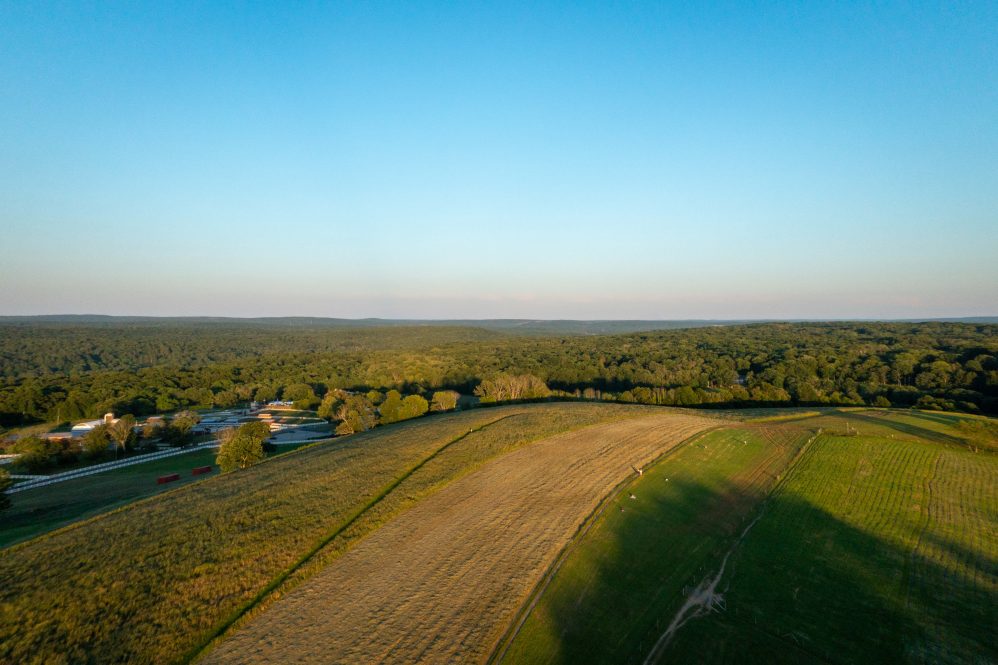If you frequently visit Horsebarn Hill, you may have noticed lots of activity over the past few years in the area behind Jacobsen’s Barn. Between extreme weather events and the work of the beautiful yet destructive Emerald Ash Borer (EAB), the UConn Forestry crew has been busy felling and processing dead trees. Though the loss of trees is unfortunate, the cleared space presents an opportunity, says Robert Fahey, Goerge F. Cloutier Professor in Forestry in the Department of Natural Resources and the Environment, the Center for Environmental Sciences and Engineering, and Director of the UConn Forest.
Fahey says the project involves constructing a new outdoor classroom to replace an existing teaching space that is not easily accessible to the campus and surrounding communities. And, he adds while gesturing around, it doesn’t have the amazing view of Horsebarn Hill.
“We were thinking about improving the access to the existing classroom and cleaning up the site but then we realized we’re clearing the stand of the ash to use for local wood products and we’re going to be opening up some space that just happens to have an amazing view. It is also very accessible to this part of campus where students and the public are. We thought it would make sense to explore building something in this area.”
The forestry crew has been busy processing wind-damaged trees including pine and spruce, and the insect-damaged ash and much of the material will be used for the construction of the pavilion, along with additional material harvested from another area of the forest closer to the Fenton that was also weather damaged, says Associate Extension Professor Thomas Worthley.
Isaac Betts (CAHNR) ’23 says this project transpired when Fahey approached him with the idea of applying for an Office of Sustainability Environmental and Social Sustainability Grant. Betts happily agreed and the grant was successful, securing $10,000 for assembling all of the materials needed for construction. Early in the summer of 2023, they started the work of building the platform.
Betts has worked in the UConn Forest as part of the Applied Forest Ecology Lab since 2022 and on the UConn Forestry crew since 2023. Betts also had experience building the ADA-compliant compostable privy on the Spring Valley Student Farm, which was also made possible with a grant through the Office of Sustainability. Fahey thought Betts had the right skill set for the project,
“He seemed like someone that would do a really good job with this and he’s excited about it. We also knew that we had enough salvaged wood from the forest to create things if we wanted to,” says Fahey.
Betts says the pavilion will have a hexagonal shape, with a 30-foot radius and the structure will be entirely timber framed. The team hopes that it will be a nice visual addition to the already stunning views of Horsebarn Hill.
Preparing the site has been hard work, says Worthley, with the tangle of vines like poison ivy and uneven ground, not to mention the challenge of digging holes for structural supports in the rocky New England soil. The platform also must be fairly high to accommodate the change in grade.
“There will be a stadium-style arrangement of seats around a speaker’s space that will look out over Horsebarn Hill and connect the audience to the forest. The site will also be cleared so we can fence it off for an American chestnut orchard and we are working with the American Chestnut Foundation to accomplish that.”
The region’s forests were once home to millions of towering American chestnuts, but after a blight decimated the species, the composition of New England forests has never been the same. Efforts like this one are underway to reintroduce blight-resistant American chestnut cultivars back to the wild.
Fahey posted signs in the area to explain the project to those visitors to the forest who may be wondering what is going on.
“We like the idea of using the disturbances that led to us clearing the area as an opportunity to try to bring back the chestnut, which was killed by a different disease,” says Fahey. “That mirroring of the stories is interesting and makes a good story to bring people out here and show them what we can do in these situations.”
Worthley says they are often approached by people who want to get involved with restoration projects and he says they always have volunteer opportunities. For example, with this project, they hope to plant black walnuts, hickory nuts, and acorns in the surrounding area to help establish a diverse mix of native species that are especially beneficial for wildlife. He also hopes that they can continue doing more invasive species control to help the future young forest develop.
Fahey says, “One thing you notice when you come out here is that there are lots of birds compared to some of the other areas of our forests, which can be pretty quiet and not especially interesting habitat for a lot of wildlife species. That is because this kind of habitat, this young forest, is missing around the state to some degree, so using this disturbance to help diversify the landscape is a great opportunity.”
Worthley points out some hallmarks of the early successional young forest, such as the dominance of herbaceous growth and a few tree sprouts here and there, and a resprouted ash tree, which Worthley explains is important because some ash trees do have resilience against the EAB. Controlling invasive species, planting plenty of new nuts and seeds, and protecting the area from browsing deer as much as possible will help the young forest get a foothold.
Betts says one sight he enjoyed while working on the site was watching hummingbirds dive-bomb one another as they vied for the best foraging space. Betts says he had never seen so many hummingbirds at one time, especially in the absence of hummingbird feeders.
Since accessibility is a main consideration in the design, Worthley says this new pavilion will have a pathway that is slope-managed and wheelchair accessible. The plan is that anyone who wants to use the space will be able to.
“In terms of classes, the Department of Natural Resources and the Environment will certainly use it, but I think there’s also the potential that any class across campus could use the space and get out on a nice day like today. Certainly, there is value in just being outside and hearing birds and seeing the view. During COVID, my class met every week at the outdoor classroom and we were able to have classes because we were entirely outside. I think having more spaces like this can make us more resilient to things like that,” says Fahey.
Betts says that compared to the compost privy, this project is moving along more slowly but that it is understandable because of the scope of this project, as well as the physical size of the materials, but he is not concerned because big projects take time, especially when you are harvesting and processing the materials at the source rather than purchasing them.
“The things we’re trying to do here are a lot bigger. The biggest things we needed for the privy were four-by-fours and here we have things that are four times that size and almost double the length, so it takes a lot more effort to move them and the logs that they’re coming from.”
The clearing and salvaging efforts are also coupled with preparing materials for other projects, like making fence posts and milling, says Worthley.
“We will get the supports put in and probably get the floor framed out. Then we will assemble some of the pieces that are going to be upright. We’d like to do a call for volunteers so we can do a barn-raising type of event. There’s a lot of preparation time and a lot of work that goes into it ahead of time to make sure that it goes smoothly, but that’s part of the process,” says Worthley.
Progress has also been very dependent on the weather and last summer and fall were exceptionally wet, which slowed efforts further. They were also trying to get as much done as possible while Betts was still on campus before his winter graduation.
“Another part of the project that has been time-consuming is doing all of the measurements just right and translating that into the timbers. We do our best to manage for natural variance in the material but sometimes it just takes a while to lay out all the joints and make sure that all the angles are just right,” says Betts. “Figuring out the joints was like a big puzzle.”
Fahey says this project is unique because it integrates so many skills, from forestry to engineering, to architecture.
“The other unique element is in thinking about how we use this space, how the university can benefit from the forest, and how that connection can help bring people out to the forest. We are making the case for the importance of the forest in lots of different ways, for example, we can put a number on how much carbon is in the forest, and how much carbon is being sequestered. However, I think making the case also through uses and value from space to have classes, but also to get the students out into the forest is important, especially in an accessible space like this.”
The forest is important to different people for different reasons, says Worthley, from exercise to studying nature, to escaping from the fast-paced and frenetic world. No matter the reason behind the connection, it is important to convey that the many benefits of the forest underscore the importance of managing and preserving the space.
“Aside from just being an aesthetic and recreational asset, it’s also working for us. We manage with habitat and the watershed in mind, and we manage with the intent of doing things with materials from our forest and this builds a material connection to the resource in people’s minds. Hopefully, this will help people understand that we want to have an asset like this, and there’s an educational benefit that we can derive in the process.”
Betts also adds the fact that harvesting and constructing resources in this way helps sequester carbon that would otherwise be released in the decomposition process. Putting that carbon to use as building materials will keep it from entering the atmosphere for a much longer period than if the wood had been allowed to decompose.
“If we can tie it up into a product long enough to grow another tree, we’ve done okay,” says Worthley. “And if you’re a little bit eccentric, why, then this is also a fun activity.”
Fahey says they hope the space is a nice one for classes or meetings, though the iconic view may be distracting. However, the connection to the surroundings the pavilion will foster is priceless.
To learn more about the UConn Forest, visit forest.uconn.edu.



